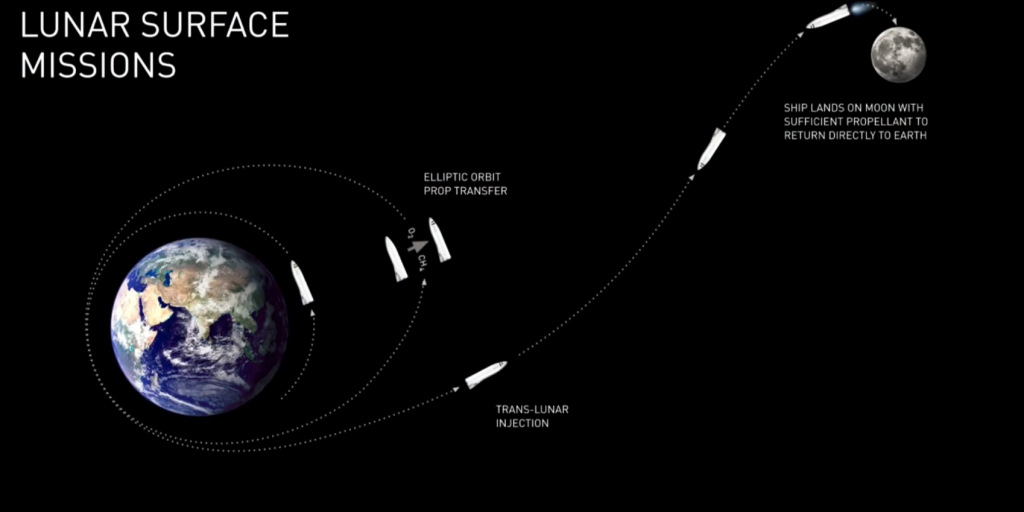Adam Crowl is going to write a journal article out his blog post analyzing the details and choices for sending the Spacex BFR to the moon and Titan. The article is at his Crowlspace website.
The Spacex BFR carries 1100 tons of propellant, masses about 85 tons and carries 150 tons of payload when in reusable mode. It can carry 250 tons one way.
The Raptor engines are designed for a specific impulse (Isp) of 375 seconds but this could be increased to 385 seconds.
The Spacex BFR has available delta-vee of 6,388 m/s. With improved ISP the delta-vee might increase to 6550 m/s.
To go the moon, the Spacex BFR would first go into a Highly Elliptical Orbit, that swings out part way to the Moon. At its closest point to the Earth, perigee, the BFR is swinging past at 10 km/s. At its high point, apogee, there’s time to transfer propellant and fill the tank. Instead of 2.75 km/s for the Trans Lunar Insertion burn, the BFR might use 0.75 km/s, and the total round-trip delta-vee required is just 5.75 km/s.
Adam Crowl looks at three options for a direct flight to Saturn from Earth orbit – a Hohmann Orbit, an Elliptical Orbit and a Parabolic Orbit. Hohmann is most energy efficient but takes about 6 years instead of 2.8-3.4 years for Elliptical or 2.3 to 2.7 years for Parabolic.
The Spacex BFR has the fuel for an elliptical orbit mission to Titan.
Parabolic orbits mean double the breaking energy when reaching Titan. If magenetoshell aerocapture technology could be made to work then the mission could be six months faster than Elliptical.


Brian Wang is a Futurist Thought Leader and a popular Science blogger with 1 million readers per month. His blog Nextbigfuture.com is ranked #1 Science News Blog. It covers many disruptive technology and trends including Space, Robotics, Artificial Intelligence, Medicine, Anti-aging Biotechnology, and Nanotechnology.
Known for identifying cutting edge technologies, he is currently a Co-Founder of a startup and fundraiser for high potential early-stage companies. He is the Head of Research for Allocations for deep technology investments and an Angel Investor at Space Angels.
A frequent speaker at corporations, he has been a TEDx speaker, a Singularity University speaker and guest at numerous interviews for radio and podcasts. He is open to public speaking and advising engagements.


Jupiter has a strong magnetic field. Perhaps something like the magnetoshell could break against that, without dipping into any atmospheres, or not dipping as much.
How about a mun gravity assist route to jupiter, (we could fly real low around mun).
Maybe even use Jool or Duna, for Patched Conic Approximation trajectory
This is only an option if whales go extinct
what kerbal is going to do this
Hi tchernik
Marcus Lindroos has convinced me that Jupiter aerocapture isn’t really worth the risk for the apparent saving. A slightly less vigorous elliptical orbit cuts out the Bi-elliptical transfer leg of the journey. I’m working on the next blog-post that discusses the alternative of a direct trajectory to Callisto. Once on Callisto, the inner Galileans can be reached pretty straight-forwardly thanks to ISRU refuelling.
Thanks. I’ll check it up when you publish it.
For me these are very interesting topics, and to think about such uses for BFR (an upcoming private rocket) is very exciting.
It makes me think abut what we could have achieved in space, had the Saturn V family continued. Probably much more than what we have, closer to what Arthur C. Clarke envisioned in 2001 and 2010.
But the past is gone and we only have the present and the future.
What about Falcon Heavy launching a nuclear powered version of Dawn. Over time–it would catch up, right?
Aero-braking on Jupiter would be… interesting to put it mildly. But it is nice not to be so restricted on launch windows.
So a few tests may be worth the risk.
Saturn, but same thing.
Yes, I’m aware the proposal focuses on Titan, which is in the general neighborhood of Saturn.
My point was more about the idea, also mentioned in the referred post, of using Jupiter for aero-braking a similar BFR-based mission, given the Jovian system doesn’t have any moons with atmosphere.
Adam acknowledged such a thing is dangerous, and now he thinks it’s better to use a slightly less optimal/fast trajectory that intersects Callisto when it is parallel to the ship’s trajectory, removing the need of aero-braking, reducing the need of propellant and allowing you to land on it.
Which is very good, because it allows us to move to Jupiter and Saturn with BFRs/BFS as they were outlined by Elon Musk last September.
Spacex launches secret military payload tomorrow.